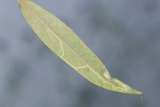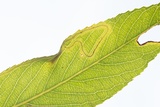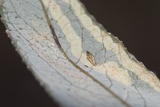Phyllocnistis valentinensis Hering, 1936 Species
Last modified: Dec. 10, 2025, 6:31 p.m.
Newly discovered in Belgium in 2013, but rapidly spread all over Flanders; currently (2020) only recorded from the provinces HA and LG in Wallonia.
Details
- Classification
- Family: Gracillariidae > Subfamily: Phyllocnistinae > Genus: Phyllocnistis > Species: Phyllocnistis valentinensis
- Vernacular names
- Geel-slakkenspoormot (NL)
- First mention in Belgium
- Wullaert S. 2019a. Resultaten van de Werkgroep Bladmineerders uit 2018 met meldingen van minerende en andere zeldzame Lepidoptera in België en met tien nieuwe soorten voor de Belgische fauna (Blastobasidae, Gelechiidae, Gracillariidae, Nepticulidae en Tortricidae). — Phegea 47(2): 30–46. On page 39 (as Phyllocnistis valentinensis Hering, 1936). view page
- Status
-
Native
Distribution
Imago
Head white; forewing ground colour silvery white, sometimes darkened with very light ochreous scales; the dorsal half of the apical area often darkened with greyish brown scales; five ochreous to brown costal striae of which the second one is prolonged to the dorsum, thus forming a narrow transversal band; a black spot in the apical area from which three dark brown hooks depart into the cilia.
The summer generation has the basal part of the forewing white, whereas the late, hibernating generation has dark grey suffusion in the basal part of the forewing. This suffusion may form an ill-defined longitudinal fascia.
Museum specimens
No pictures yet!Specimens in nature
No pictures yet!Mine
A long winding corridor on the upper side of a leaf. The frass is concentrated in a very narrow central frass line; the mine itself has a yellowish appearance, distinguishing it from the other Phyllocnistis mines.
See also gracillariidae.net and bladmineerders.be.
Bionomics
The eggs are oviposited mainly on the upperside of the leaf.
Pupation under a flimsy membrane at the end of the corridor at the margin of a leaf, which is turned over the membrane.
The adults are active at dusk and hibernate in the adult stage.
Flight periods
Not much is known about the situation in Belgium; but probably moths can be found from late November, hibernating till April–May.
Observed on
- Host plant (species):
- Salix alba, Salix fragilis, Salix babylonica and Salix triandra
- Host plant (genera):
- Salix
The caterpillar lives on different species of narrow-leaved Salix trees, like Salix alba, S. babylonica, S. fragilis, and S. triandra.



